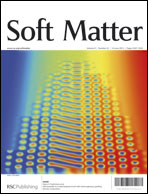While theoretical and numerical studies have shown the possibility of obtaining long-range ordering from the self-assembly of A–B binary mixed brushes similar to diblock copolymer thin films, such ordered patterns are not currently obtainable experimentally. In addition, most experimental observations of mixed brushes show relatively short range order with many defective structures. One explanation for poor microdomain ordering in experimental mixed brushes is a strong correlation between the spatial distribution of the grafting points and the self-assembly. To investigate this relationship in detail, we use self-consistent field theory (SCFT) simulations to study the phase-separated morphologies of melt mixed brushes with spatially varying grafting density compositions. Variations in the grafting density composition are implemented by modulating the grafting chain end distribution function to locally control the ratio of A and B chains attached to the surface, while maintaining uniform total grafting density. Three different types of grafting density composition variations are investigated: a linear ramping of the grafting density composition, deterministic sinusoidal variations, and random fluctuations with various correlation lengths and strengths. The resulting patterns in the micro-phase separated brush are seen to depend sensitively on both the wavelengths and amplitudes of the imposed grafting density fluctuations.

You have access to this article
 Please wait while we load your content...
Something went wrong. Try again?
Please wait while we load your content...
Something went wrong. Try again?


 Please wait while we load your content...
Please wait while we load your content...